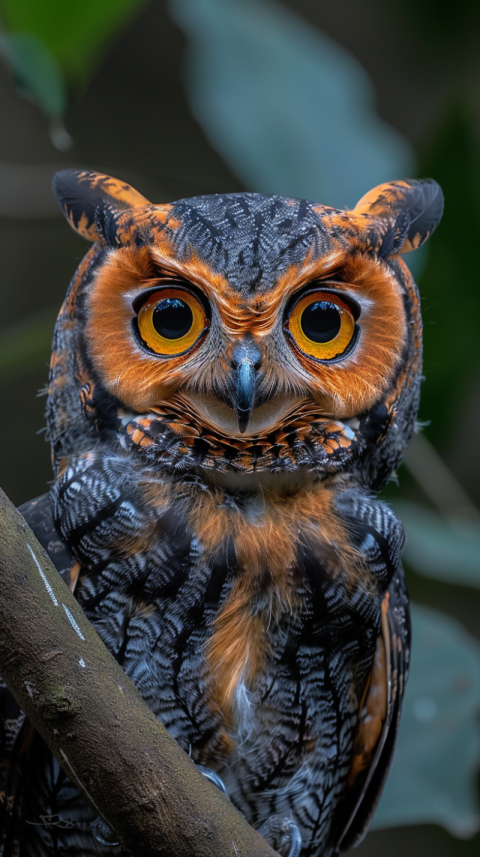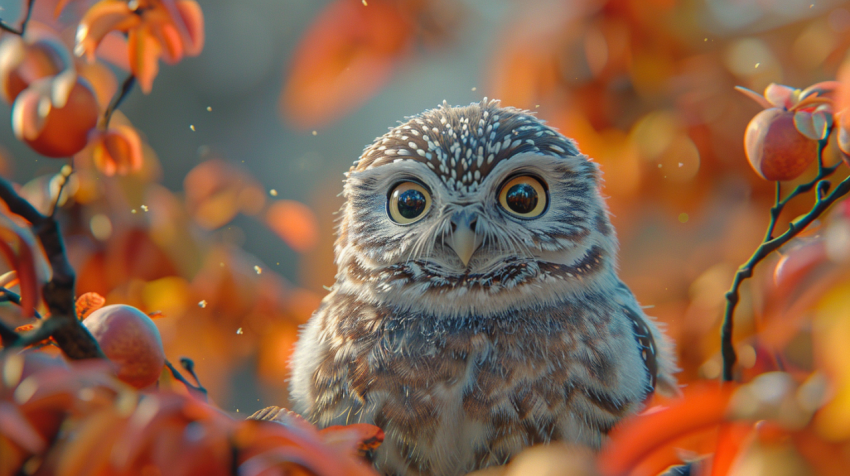











Owls: Silent Hunters of the Night
Owls, with their enigmatic stares, silent flight, and nocturnal habits, have long held a place in human folklore and mythology. Often associated with wisdom, mystery, and even the supernatural, these captivating birds of prey are highly specialized predators that play a vital role in their ecosystems. This comprehensive guide will explore the fascinating world of owls, examining their unique physical characteristics, adaptations for nocturnal hunting, diverse species, global distribution, breeding behaviors, cultural significance, and conservation status.
What Defines an Owl?
Owls belong to the order Strigiformes, which is divided into two families: Strigidae (typical owls) and Tytonidae (barn owls). There are over 200 species of owls found worldwide, exhibiting a remarkable diversity in size, appearance, and habitat.
Key Characteristics of Owls:
- Nocturnal Habits: Most owls are nocturnal, meaning they are active primarily at night. Some species, however, are crepuscular (active during dawn and dusk) or even diurnal (active during the day).
- Forward-Facing Eyes: Owls have large, forward-facing eyes that provide excellent binocular vision and depth perception, crucial for hunting in low-light conditions. Unlike most birds, an owl's eyes are fixed in their sockets. To look in a different direction, an owl must turn its entire head.
- Facial Disk: A distinctive feature of owls is their facial disk, a concave collection of feathers surrounding the eyes that helps to funnel sound to their ears, enhancing their hearing.
- Asymmetrical Ears: Many owl species have asymmetrical ear openings, meaning one ear is higher on the head than the other. This asymmetry helps them pinpoint the location of sounds with great accuracy.
- Silent Flight: Owls are renowned for their silent flight, made possible by specialized feathers with serrated edges (on the leading edge) and a soft, velvety texture (on the trailing edge and on their legs and feet) that dampen the sound of air passing over their wings.
- Sharp Talons and Beak: Owls have powerful feet with sharp talons, used for capturing and killing prey. Their beaks are short, curved, and strong, adapted for tearing flesh.
- Cryptic Coloration: Most owls have cryptic plumage, with mottled patterns of brown, gray, black, and white that provide excellent camouflage against tree bark or the forest floor.
Adaptations for Nocturnal Hunting:
Owls have evolved a suite of remarkable adaptations that make them highly effective nocturnal predators:
- Exceptional Night Vision: While owls cannot see in complete darkness, their eyes are extremely sensitive to low levels of light. Their pupils can dilate widely to let in more light, and their retinas contain a high density of rod cells, which are photoreceptor cells that are sensitive to low light.
- Acute Hearing: Owls have exceptional hearing, which is crucial for locating prey in the dark. Their facial disk acts like a parabolic reflector, channeling sound waves to their ears. The asymmetrical placement of their ears allows them to determine the precise location of a sound source through a process called triangulation.
- Silent Flight: As mentioned, the specialized structure of owl feathers allows for virtually silent flight, enabling them to approach prey undetected.
Diverse Owl Species:
There are over 200 owl species found worldwide, ranging in size from the tiny Elf Owl to the imposing Eurasian Eagle-Owl. Some notable owl species include:
- Barn Owl (Tyto alba): One of the most widespread owl species, the Barn Owl is found on every continent except Antarctica. It is known for its heart-shaped facial disk and distinctive screeching call.
- Great Horned Owl (Bubo virginianus): A large and powerful owl found throughout the Americas, the Great Horned Owl is known for its prominent ear tufts (which are not actually ears) and deep hooting call.
- Snowy Owl (Bubo scandiacus): A striking white owl that breeds in the Arctic tundra, the Snowy Owl is well-adapted to cold, harsh environments.
- Eurasian Eagle-Owl (Bubo bubo): One of the largest owl species in the world, the Eurasian Eagle-Owl is found across Europe and Asia.
- Burrowing Owl (Athene cunicularia): A small, ground-dwelling owl found in the Americas, the Burrowing Owl is unique in that it nests and roosts in burrows, often those dug by other animals.
- Elf Owl (Micrathene whitneyi): The smallest owl in the world, the Elf Owl is found in the southwestern United States and Mexico, where it inhabits deserts and woodlands.
- Barred Owl (Strix varia): A common owl of eastern North American forests, the Barred Owl is known for its distinctive call, often described as sounding like "Who cooks for you? Who cooks for you all?"
Global Distribution and Habitats:
Owls are found on every continent except Antarctica and inhabit a wide range of environments:
- Forests: Many owl species are adapted to forest environments, from dense coniferous forests to tropical rainforests.
- Grasslands and Savannas: Some owls, like the Burrowing Owl, prefer open grasslands and savannas.
- Deserts: Certain owl species, such as the Elf Owl, are adapted to arid desert environments.
- Tundra: The Snowy Owl is a specialist of the Arctic tundra.
- Urban and Suburban Areas: Some owl species, like the Barn Owl and the Eastern Screech-Owl, have adapted to living near humans and can be found in urban and suburban areas.
Hunting Strategies and Diet:
Owls are carnivorous predators, and their diet varies depending on the species and their habitat.
- Hunting Techniques: Owls employ various hunting techniques, including:
- Perch and Pounce: Many owls hunt by perching on a high vantage point, such as a tree branch or fence post, and waiting for prey to come within range. They then swoop down silently and snatch the prey with their talons.
- Low Flight: Some owls, like the Short-eared Owl, hunt by flying low over open ground, using their keen hearing to locate prey.
- Still Hunting: Involves waiting patiently for prey to approach.
- Dietary Preferences: Common prey items for owls include:
- Small Mammals: Rodents, such as mice, voles, rats, and squirrels, make up a significant portion of the diet of many owl species.
- Birds: Some owls, particularly larger species, prey on other birds, including songbirds, pigeons, and even smaller raptors.
- Insects: Many owls, especially smaller species, consume insects, such as beetles, moths, and grasshoppers.
- Reptiles and Amphibians: Some owls will also prey on reptiles (like snakes and lizards) and amphibians (like frogs and toads).
- Fish: Certain owl species, such as the Blakiston's Fish Owl of Asia, are specialized fish eaters.
Breeding and Nesting:
- Courtship: Owl courtship often involves vocalizations, with males and females engaging in duets. Some species also perform aerial displays or present food offerings to their mates.
- Nesting Sites: Owls do not typically build their own nests. Instead, they use a variety of nesting sites, including:
- Tree Cavities: Many owl species nest in natural tree cavities or those excavated by woodpeckers.
- Abandoned Nests: Owls may also use the abandoned nests of other birds, such as hawks or crows.
- Cliff Ledges: Some owls, like the Eurasian Eagle-Owl, nest on cliff ledges.
- Burrows: Burrowing Owls, as their name suggests, nest in burrows in the ground.
- Human-Made Structures: Certain owl species, like Barn Owls, readily adapt to nesting in human-made structures, such as barns, silos, and nest boxes.
- Eggs: Female owls lay a clutch of round, white eggs. The clutch size varies by species but typically ranges from 2 to 10 eggs.
- Incubation: The female owl usually does most of the incubation, while the male provides her with food. The incubation period lasts for about 30-40 days, depending on the species.
- Hatching and Fledging: Owl chicks, called owlets, are covered in downy feathers when they hatch. They are initially helpless and rely entirely on their parents for food and warmth. Both parents care for the owlets, bringing them food and protecting them from predators. The owlets fledge (leave the nest) after a period that varies by species, typically ranging from 4 to 12 weeks.
Cultural Significance:
Owls have held diverse symbolic meanings in human cultures throughout history:
- Wisdom and Knowledge: In many cultures, particularly in Western traditions, owls are associated with wisdom, knowledge, and learning. This association may stem from their large, forward-facing eyes, which give them an appearance of intelligence, and their ability to see in the dark, symbolizing the ability to perceive hidden truths. In Greek mythology, the owl was associated with Athena, the goddess of wisdom.
- Death and the Supernatural: In some cultures, owls are seen as omens of death or messengers from the spirit world. Their nocturnal habits, silent flight, and eerie calls have contributed to these associations.
- Protection and Good Luck: In other cultures, owls are viewed as protectors or bringers of good luck.
- Native American Traditions: In many Native American cultures, owls hold significant spiritual meaning. They are often seen as powerful beings with connections to the spirit world. Some tribes view owls as messengers or guardians, while others associate them with death or the supernatural.
Conservation Status:
The conservation status of owl species varies widely.
- Least Concern: Many owl species, such as the Barn Owl and the Great Horned Owl, are widespread and abundant and are classified as species of Least Concern by the IUCN.
- Threatened Species: Some owl species face significant threats, including:
- Habitat Loss and Degradation: The loss and fragmentation of owl habitats due to deforestation, urbanization, and agriculture are major threats to many owl populations.
- Prey Depletion: Declines in prey populations due to habitat loss, pesticide use, or other factors can negatively impact owl populations.
- Collisions with Vehicles and Power Lines: Owls are vulnerable to collisions with vehicles and power lines, particularly in areas where their habitats are fragmented by roads and other infrastructure.
- Persecution: In some areas, owls have been persecuted by humans due to superstitions or perceived threats to livestock or game birds.
- Climate Change: Climate change may affect owl populations by altering habitats, prey availability, and weather patterns.
Conservation Efforts:
Various conservation efforts are underway to protect owl populations worldwide:
- Habitat Protection and Restoration: Conservation organizations and government agencies are working to protect and restore owl habitats, such as forests, grasslands, and wetlands.
- Nest Box Programs: Providing artificial nest boxes can help support populations of cavity-nesting owls, particularly in areas where natural cavities are limited.
- Public Education: Raising public awareness about the importance of owl conservation and the threats they face is crucial for their long-term survival.
- Research and Monitoring: Ongoing research and monitoring programs help scientists better understand owl ecology, population trends, and conservation needs.
- Legal Protection: Many owl species are protected by national and international laws.
Conclusion:
Owls are fascinating and ecologically important birds that have captivated humans for centuries. Their remarkable adaptations for nocturnal hunting, diverse species, and mysterious nature make them a source of endless wonder. By understanding the challenges they face and supporting conservation efforts, we can help ensure that these silent hunters of the night continue to grace our world for generations to come. Their presence enriches our ecosystems and reminds us of the intricate beauty and interconnectedness of the natural world.
Owl, Types of Owls, Owl Facts, Owl Adaptations, Owl Habitat, Owl Diet, Owl Hunting, Owl Eyes, Owl Hearing, Owl Feathers, Silent Flight, Owl Species, Barn Owl, Great Horned Owl, Snowy Owl, Elf Owl, Owl Sounds, Owl Calls, Owl Hoot, Owl Pellets, Owl Symbolism, Owl Meaning, Owl Mythology, Owl Conservation, Are Owls Endangered, Owl Lifespan, Owl Predators, Owl Babies, Owlets, Owl Nest, Owl Eggs, What Do Owls Eat, Where Do Owls Live, Owl Pictures, Owl Videos, How to Identify Owls.

